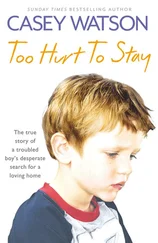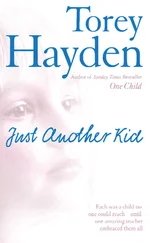” It was the last year before congressional law would introduce “mainstreaming,” the requirement that all special needs children be educated in the least restrictive environment; and thus, our district still had the myriad of small special education classrooms, each catering to a different disability. There were classes for physically handicapped, for mentally handicapped, for behaviorally disordered, for visually impaired … you name it, we had it. My eight were the kids left over, the ones who defied classification. All of them suffered emotional disorders, but most also had mental or physical disabilities as well. Out of the three girls and five boys in the group, three could not talk, one could but refused and another spoke only in echoes of other people’s words. Three of them were still in diapers and two more had regular accidents. As I had the full number of children allowed by state law for a class of severely handicapped children, I was given an aide at the start of the year; but mine hadn’t turned out to be one of the bright, hardworking aides already employed by the school, as I had expected. Mine was a Mexican-American migrant worker named Anton, who had been trawled from the local welfare list. He’d never graduated from high school, never even stayed north all winter before, and certainly had never changed diapers on a seven-year-old. My only other help came from Whitney, a fourteen-year-old junior high student, who gave up her study halls to volunteer in our class.
By all accounts we didn’t appear a very promising group, and in the beginning, chaos was the byword; however, as the months passed, we metamorphosed. Anton proved to be sensitive and hardworking, his dedication to the children becoming apparent within the first weeks. The kids, in return, responded well to having a man in the classroom and they built on one another’s strengths. Whitney’s youth occasionally made her more like one of the children than one of the staff, but her enthusiasm was contagious, making it easier for all of us to view events as adventures rather than the disasters they often were. The kids grew and changed, and by Christmas we had become a cohesive little group. Now Ed was sending me a six-year-old stick of dynamite.
Her name was Sheila. The next Monday she arrived, being dragged into my classroom by Ed, as my principal worriedly brought up the rear, his hands flapping behind her as if to fan her into the classroom. She was absolutely tiny, with fierce eyes, long, matted blond hair and a very bad smell. I was shocked to find she was so small. Given her notoriety, I had expected something considerably more Herculean. As it was, she couldn’t have been much bigger than the three-year-old she had abducted.
Abducted? I regarded her carefully.
Bureaucracy being what it is in school districts, Sheila’s school files didn’t arrive before she did; so when she went off to lunch on that first day, Anton and I took the opportunity to go down to the office for a quick look. The file made bleak reading, even by the standards of my class.
Our town, Marysville, was in proximity to a large mental hospital and a state penitentiary, and this, in addition to the migrants, had created a disproportionate underclass, many of whom lived in appalling poverty. The buildings in the migrant camp had been built as temporary summer housing and many were literally nothing but wood and tar paper that lacked even the most basic amenities, but they became crowded in the winter by those who could afford nothing better. It was here that Sheila lived with her father.
A drug addict with alcohol problems, her father had spent most of Sheila’s early years in and out of prison. He had no job. Currently on parole, he was attending an alcohol abuse program, but doing little else.
Sheila’s mother had been only fourteen when, as a runaway, she took up with Sheila’s father and became pregnant. Sheila was born two days before her mother’s fifteenth birthday. A second child, a son, was born nineteen months later. There wasn’t much else relating to the mother in the file, although it was not hard to read drugs, alcohol and domestic violence between the lines. Whatever, she must have finally had enough, because when Sheila was four, she left the family. From the brief notes, it appeared that she had intended to take both children with her, but Sheila was later found abandoned on an open stretch of freeway about thirty miles south of town. Sheila’s mother and her brother, Jimmie, were never heard from again.
The bulk of the file detailed Sheila’s behavior. At home the father appeared to have no control over her at all. She had been repeatedly found wandering around the migrant camp late at night. She had a history of fire setting and had been cited for criminal damage three times by the local police, quite an accomplishment for a six-year-old. At school, Sheila often refused to speak, and as a consequence, virtually nothing was contained in the file to tell me what or how much she might have learned. She had been in kindergarten and then first grade in an elementary school near the migrant camp until the incident with the little boy had occurred, but there were no assessment notes. In place of the usual test results and learning summaries was a catalog of horror stories detailing Sheila’s destructive, often violent, behavior.
At the end of the file was a brief summary of the incident with the toddler. The judge concluded that Sheila was out of parental control and would be best placed in a secure unit, where her needs could be better met. In this instance, he meant the children’s unit at the state mental hospital. Unfortunately, the unit was at capacity at the time of the hearing, and thus, Sheila would need to await an opening. A recently dated memo was appended detailing the need to provide some form of education, given her age and the law, but no one bothered to mince words. Her placement was custodial. This meant she had to be kept in school for the time being, because of the specifics of the law, but I need not feel under any obligation to teach her. With Sheila’s arrival, my room had become a holding pen.
Youth was my greatest asset at that point in my career. Still fired with idealism, I felt strongly that there were no problem kids, only a problem society. Although initially reluctant to take Sheila, it had been because my room was crowded and my resources overstretched already, not because of the child herself. Thus, once I had her, I regarded her as mine and my class was no holding pen! My belief in human integrity and the inalienable right of each and every one of my children to possess it was trenchant.
Well, almost. Before she was done, Sheila had given all my beliefs a good shaking and she started that very first day. As Anton and I were sitting in the front office that lunch hour, reading Sheila’s file, Sheila was in our classroom scooping the goldfish out of the aquarium and, one by one, poking their eyes out.
Sheila proved to be chaos dressed in outgrown overalls and a faded T-shirt. Everything she said was shrieked. Everything she touched was broken, hit, squashed or mangled. And everyone, myself included, was The Enemy. She operated in what Anton christened her “animal mode.” There was not much “child mode” present in the early days. The slightest unexpected movement she always interpreted as attack. Her eyes would go dark, her face would flush, her body would take on alert rigidity, and from that point it was a finely balanced matter as to whether she would fight, or panic and run away. When she was in her animal mode, our methods were a whole lot more akin to taming than teaching.
Yet …
Sheila was different. There was something electric about her, about her eyes, about the sharpness of her movements that superimposed itself over even her most feral moments. I couldn’t articulate what it was, but I could sense it.
Читать дальше












